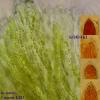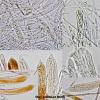
21-12-2025 09:32
Hello.A tiny ascomycete found embedded in wood in

21-12-2025 21:32
Pol DebaenstHello, Garden, Burgweg 19, Veurne, BelgiumOn 10/1

22-12-2025 23:38
Patrice TANCHAUDBonsoir, rûˋcolte sur un mur en pierre, apothûˋci

22-12-2025 00:47
Patrice TANCHAUDBonsoir, rûˋcolte û proximitûˋ du milieu dunaire

21-12-2025 21:40
Isabelle CharissouBonjour, j'aimerais connaitre les rûˋfûˋrences de

20-12-2025 23:08
Patrice TANCHAUDBonsoir, rûˋcolte sur sol sablonneux dans l'arriû
Gorgoniceps viridula ?
Miguel ûngel Ribes,
27-02-2010 16:08
 I think this is Gorgoniceps viridula, isn't it?
I think this is Gorgoniceps viridula, isn't it?Spores (1000x, in water, fresh material)
45.2 [58.5 ; 63.8] 77 x 1.8 [2.2 ; 2.4] 2.9
Q = 17.2 [24.9 ; 28] 35.8 ; N = 36 ; C = 95%
Me = 61.13 x 2.34 ; Qe = 26.49
Asci (1000x, in water and IKI, fresh material)
89.5 [105.1 ; 111.1] 126.8 x 7.9 [9.4 ; 10] 11.5
N = 39 ; C = 95%; Me = 108.12 x 9.67
Thanks,
Miguel
Hans-Otto Baral,
27-02-2010 16:39

Re:Gorgoniceps viridula ?
Hi Miguel
It is interesting for me to see this greenish fungus for the first tine n a photo. You are surely right with G. viridula Huht. & Iturriaga, everything fits. I have only probolems with G. aridula (Karst.)Karst. when reading Huhtinen & Iturriagas paper in Mycotaxon 29: 189 (1987). They provide a drawing of holotype material of both species, and they look very much the same. The colour of the apos is different, and the spores are said to get longer in aridula with more septa, and the asci wider. G. viridula is said to be quite common in Finland on Pinus bark.
But they say nothing on the ecology of G. aridula. Did they not have any personl find of this? My drawing of G. aridula on a Picea cone has actually grey apothecia without green, but the spores are of the same size as in G. viridula, and the septa are also 7, and the asci correspond to this species too when considering the shrinking effect.
So I think that G. aridula should be recollected in Finland on its original substrate (probably also Pinus) and compared in the fresh state before judging on whether there really exist two species.
Zotto
It is interesting for me to see this greenish fungus for the first tine n a photo. You are surely right with G. viridula Huht. & Iturriaga, everything fits. I have only probolems with G. aridula (Karst.)Karst. when reading Huhtinen & Iturriagas paper in Mycotaxon 29: 189 (1987). They provide a drawing of holotype material of both species, and they look very much the same. The colour of the apos is different, and the spores are said to get longer in aridula with more septa, and the asci wider. G. viridula is said to be quite common in Finland on Pinus bark.
But they say nothing on the ecology of G. aridula. Did they not have any personl find of this? My drawing of G. aridula on a Picea cone has actually grey apothecia without green, but the spores are of the same size as in G. viridula, and the septa are also 7, and the asci correspond to this species too when considering the shrinking effect.
So I think that G. aridula should be recollected in Finland on its original substrate (probably also Pinus) and compared in the fresh state before judging on whether there really exist two species.
Zotto
Miguel ûngel Ribes,
27-02-2010 17:53

Re:Gorgoniceps viridula ?
I am happy to show you this photos. Every time your are learning me, so I am glad about your interest.
I can not help you with G. aridula, sorry.
Thank you,
Miguel
I can not help you with G. aridula, sorry.
Thank you,
Miguel
Richard Korf,
27-02-2010 18:50
Re:Gorgoniceps viridula ?
Could this be a Vibrissea?
Dick
Dick
Hans-Otto Baral,
27-02-2010 18:57

Re:Gorgoniceps viridula ?
Gorgoniceps has actually some similarity with Vibrissea, but it lacks amyloid tissue in the medulla, and the excipulum is more that of a Durella.
Zotto
Zotto
Richard Korf,
02-03-2010 18:16
Re:Gorgoniceps viridula ?
Dear Miguel and Zotto,
I now realize that probably my memory of the paper by Iturriaga (Mycotaxon 61: 215-221.1997) describing Vibrissea pfisteri Iturr. & Korf, remarkably similar to Miguel's find, made me ask if it could be a Vibrissea. From the very beginning I felt its placement in Vibrissea was highly suspect, based primarily on the non-aquatic habitat. The many spores lying on the apothecial surface was very like what we see in Vibrissea (and Miguel's photos also emphasize that), and probably overly influenced us. I don't know what a cross section of Miguel's fungus would show: the description of Iturriaga suggests to me a different structure than Durella, But do note that she commented on the lack of any bluing of the excipulum.
Given all this, and the fact that apparently none of the three of us, Pfister, Iturriaga, or I, apparently ever even considered that what we had was a Gorgoniceps species now makes me pretty certain that V. pfisteri was misplaced, and is a species (maybe previously described?) of Gorgoniceps.
Zotto, would you like to see the type specimen of "V." pfisteri? I'd like either to join you in transferring it to Gorgoniceps or to find an older name for it.
Dick
I now realize that probably my memory of the paper by Iturriaga (Mycotaxon 61: 215-221.1997) describing Vibrissea pfisteri Iturr. & Korf, remarkably similar to Miguel's find, made me ask if it could be a Vibrissea. From the very beginning I felt its placement in Vibrissea was highly suspect, based primarily on the non-aquatic habitat. The many spores lying on the apothecial surface was very like what we see in Vibrissea (and Miguel's photos also emphasize that), and probably overly influenced us. I don't know what a cross section of Miguel's fungus would show: the description of Iturriaga suggests to me a different structure than Durella, But do note that she commented on the lack of any bluing of the excipulum.
Given all this, and the fact that apparently none of the three of us, Pfister, Iturriaga, or I, apparently ever even considered that what we had was a Gorgoniceps species now makes me pretty certain that V. pfisteri was misplaced, and is a species (maybe previously described?) of Gorgoniceps.
Zotto, would you like to see the type specimen of "V." pfisteri? I'd like either to join you in transferring it to Gorgoniceps or to find an older name for it.
Dick
Hans-Otto Baral,
02-03-2010 20:28

Re:Gorgoniceps viridula ?
Dear Dick
the description of the ectal excipulum actually fits better to Gorgoniceps: "brownish, of a textura porrecta, cells turning outwards at an acute angle relative to surface of receptacle" And the thick-walled cells also probably fit.
About the family placement of Gorgoniceps by molecular data is probably nothing known. Maybe the excipulum is valuable to separate from Vibrisseaceae.
What I am mainly interested here is the substrate which is unidentified wood. Gorgoniceps seems only known from conifers, as far as I am aware, so to clarify this in the type of V. pfisteri would be a quite easy work.
So, in getting an offer of a specimen for study I would say yes.
Zotto
the description of the ectal excipulum actually fits better to Gorgoniceps: "brownish, of a textura porrecta, cells turning outwards at an acute angle relative to surface of receptacle" And the thick-walled cells also probably fit.
About the family placement of Gorgoniceps by molecular data is probably nothing known. Maybe the excipulum is valuable to separate from Vibrisseaceae.
What I am mainly interested here is the substrate which is unidentified wood. Gorgoniceps seems only known from conifers, as far as I am aware, so to clarify this in the type of V. pfisteri would be a quite easy work.
So, in getting an offer of a specimen for study I would say yes.
Zotto
Richard Korf,
02-03-2010 21:41
Re:Gorgoniceps viridula ?
Dear Zotto,
I'll look to get you a part of the type quickly, hopefully this week. Thanks for your interest.
Dick
I'll look to get you a part of the type quickly, hopefully this week. Thanks for your interest.
Dick
Hans-Otto Baral,
02-03-2010 22:15

Re:Gorgoniceps viridula ?
Thanks, loooking forward!
by the way, do you have contacts to TRTC? We ordered the type of orbilia fimicola Jeng & Krug (1977) perhaps 1-2 years ago, but never got an answer from the herbarium. I met JC Krug in 1990, but I think he is retired now.
Zotto
by the way, do you have contacts to TRTC? We ordered the type of orbilia fimicola Jeng & Krug (1977) perhaps 1-2 years ago, but never got an answer from the herbarium. I met JC Krug in 1990, but I think he is retired now.
Zotto
Richard Korf,
02-03-2010 22:57
Re:Gorgoniceps viridula ?
I'll look up what's happening at TRTC.
Dick
Dick
Richard Korf,
02-03-2010 22:58
Re:Gorgoniceps viridula ?
I'll look up what's happened at TRTC.
Dick
Dick
Hans-Otto Baral,
23-03-2010 22:21

Re:Gorgoniceps viridula ?
The type of Vibrissea pfisteri arrived, thank you Dick, and it is indeed Gorgoniceps aridula. The unidentified substrate is clearly wood of a conifer. The only problem is G. viridula, for which I know little more than the colour as character separating it from G. aridula.
Asci with croziers, IKI bb, KOH+CR 110-115 x 10-13.5 ôçm, spores KOH 73-78 x 2.2-2.5 ôçm.
Zotto
Asci with croziers, IKI bb, KOH+CR 110-115 x 10-13.5 ôçm, spores KOH 73-78 x 2.2-2.5 ôçm.
Zotto
Richard Korf,
24-03-2010 04:38
Re:Gorgoniceps viridula ?
Thanks, Zotto, I appreciate your advice. Unfortunately I know nothing about Gorgoniceps viridula. I see they claim an isotype is in CUP. I can look for it and send a bit for you to examine.
V. pfisteri bites the dust. I'll advise Teresita.
Best to you and your famaily,
Dick
V. pfisteri bites the dust. I'll advise Teresita.
Best to you and your famaily,
Dick
Hans-Otto Baral,
24-03-2010 13:08

Re:Gorgoniceps viridula ?
Dear Dick
yes, if you wish to send I will look at viridula too. The micros are very probably very similar in the two, i fear. maybe the colour is still there.
Zotto
yes, if you wish to send I will look at viridula too. The micros are very probably very similar in the two, i fear. maybe the colour is still there.
Zotto
Hans-Otto Baral,
22-04-2010 22:06

Re:Gorgoniceps viridula ?
Now I looked at the type of G. viridula. Two things are interesting: a strong yellow pigment is found, I saw it mainly inside asci! And the ascus apical ring is partly negative and otherwise only very faintly reactive in KOH + IKI.
Huhtinen & Iturriaga say minute but clearly blue in MLZ without KOH. And they say greenish-yellow droplets in juvenile asci and paraphyses. Would be interesting to see living asci, I assume they are without this pigment.
Miguel, did you see any such yellow particles?
Zotto
Huhtinen & Iturriaga say minute but clearly blue in MLZ without KOH. And they say greenish-yellow droplets in juvenile asci and paraphyses. Would be interesting to see living asci, I assume they are without this pigment.
Miguel, did you see any such yellow particles?
Zotto
Miguel ûngel Ribes,
22-04-2010 23:50
Hans-Otto Baral,
23-04-2010 13:17

Re:Gorgoniceps viridula ?
O.k., but the differences are not very distinct, so I think G. viridula is a good name for your fungus. I hope to see at some time G. viridula fresh from Skandinavia.
Zotto
Zotto

 10583.pdf
10583.pdf

